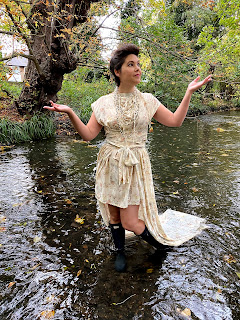I usually like to write a blog post around Halloween about the historical horrors of the fashion industry (it’s a great excuse to dress up) and then compare the terrible decisions of days gone by with the state of the industry today (the life cycle of a pair of jeans is scarier than most of the monstrous scenarios Hollywood can conjure up). But after everything that’s been happening this year I wanted to create and write something that has an element of hope to it; the idea that although we continue to make dangerous mistakes we also have the capacity to learn from them, correct them, and improve the world around us rather than adding to its degradation.
You may remember from my earlier post about textile waste along the Wandle that I found a huge pile of fabrics just outside Watermeads Nature Reserve, and carried it all home for washing and rehoming. So many of these vintage fabrics captured my imagination that I’m planning a whole capsule collection of clothes. Most will be very practical and wearable, a few will have more of an element of the theatrical to them, telling a story about the history of the river and its current users and inhabitants.
So let me introduce the first of these creations, the Egret Dress. Made from three metres of lightweight synthetic viscose with an abstract floral print in creams and browns, this dress is entirely zero-waste as all the fabric offcuts were used to make the matching jewellery. The train is detachable, so the dress functions as a wearable summer minidress as well as a strong fashion statement.
The Egret is a shy but frequent visitor to my home stretch of the Wandle, wading and fishing in the shallow water but quickly taking flight if it’s spotted. This suspicion of people is well founded; from the mid-19th Century to the 1910s the Egret was hunted mercilessly for its distinctive breeding plumage, which would adorn the hats of well-to-do ladies. It became locally extinct in northwest Europe, but after conservation measures were introduced in the 1950s, populations in southern Europe increased, and the Egret returned to England as a breeding species at the end of the 20th Century, and is now common around the River Thames.
Like the murderous millinery trade, so much of fashion’s beauty and decadence has an ugly side, but this doesn’t need to be the case any more. We have enough understanding of the damage we’re doing and enough resources at our disposal to stop doing that damage right now. What we need is imagination, and the ability to think differently about what beauty might mean to us. To see the beauty and potential in something unwanted and discarded, and to see the beauty of the natural world as something that is available as inspiration, but isn’t there for us to take and exploit.
The River Wandle was once an important part of Britain’s textile industry, ideal at first for calico bleaching as its water was so clean. The ebb and flow of industry meant that by the 1960s the Wandle was so polluted it was declared a “dead” river, but now, thanks to river-wide co-operation, it is an excellent wildlife habitat. We need to have the vision and the determination to clean up our act elsewhere. It’s possible to evoke the beauty and glamour of the most excessive of eras without replicating the exploitation and cruelty, and it’s possible (if you happen to walk past Watermeads at just the right time) to turn trash into wearable treasure.












No comments:
Post a Comment